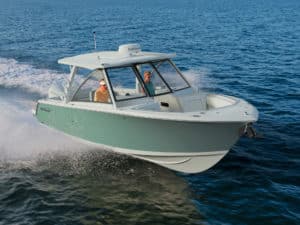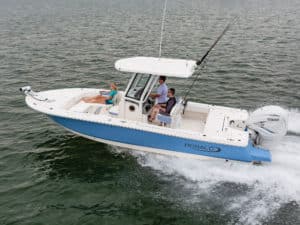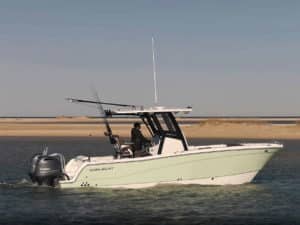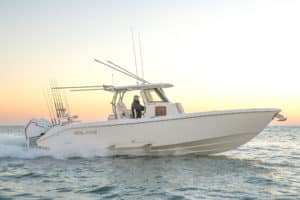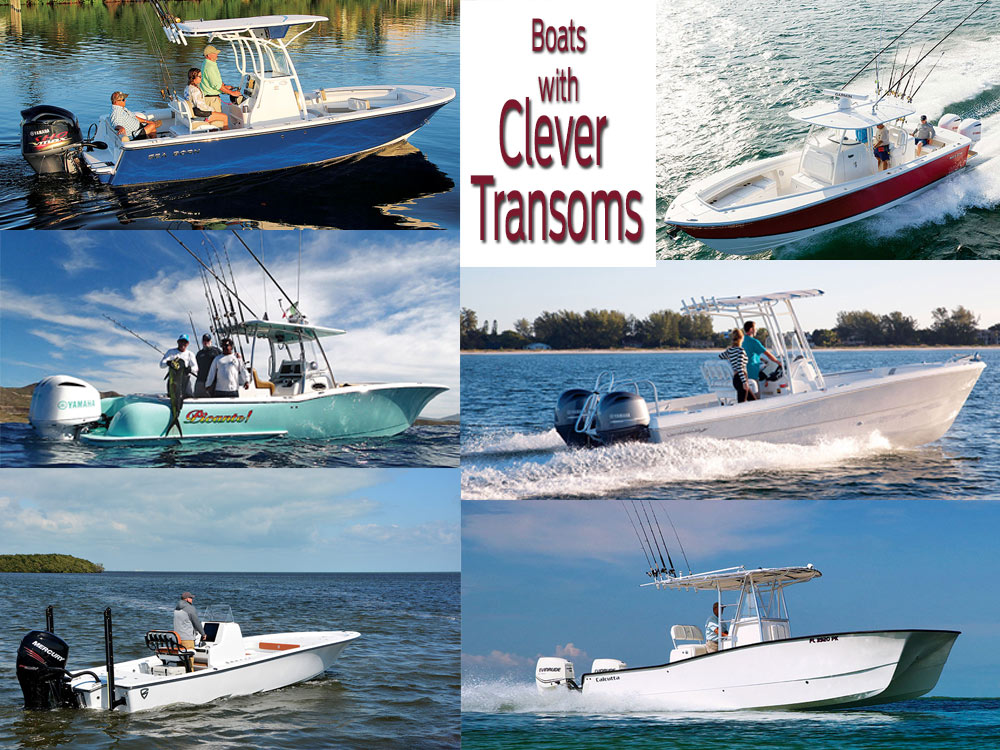
While anglers buying boats often focus on deck layouts and brand reputations — important considerations for sure — a fishing vessel’s hull design and indeed its transom can also speak volumes about its fishability and comfort.
Consider that most fishermen spend a great deal of time at the aft end of the cockpit, and it’s easy to realize how integral a transom design can be: Does it allow easy passage of a rod over the outboards? Does it permit easy boating or releasing of fish? Does it create more usable fishing space? Does it properly counterbalance heavy outboards? And in today’s world, where family fishing and boating has started to outweigh hardcore angling on the minds of more and more buyers: What does the transom design offer the nonanglers aboard?
To take a look at a variety of fairly unique designs, we identified six builders offering different kinds of aft aesthetics. Here’s what they told us about transoms. (Boats are randomly ordered.)
Calcutta 263
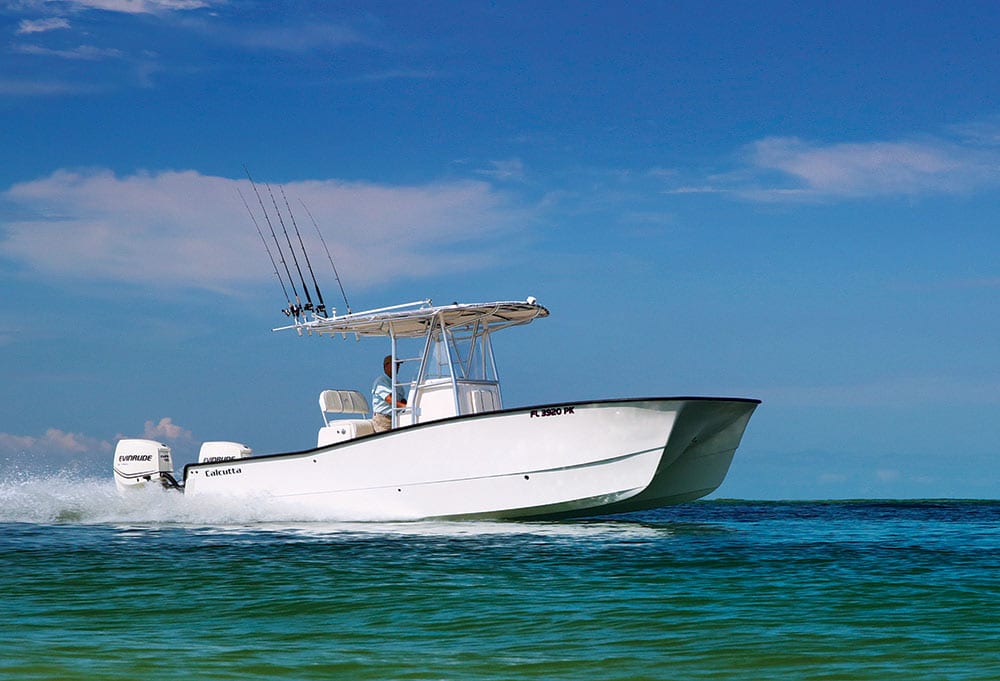
Calcutta’s 263 features a transom that disappears into a recess in the deck when lowered; the company calls it a sea gate. “It’s not just a splash board; it’s a sealed door,” says Steve Ellis, president of Calcutta Boats in Palmetto, Florida. “There’s also nonskid on the side of the door.”
With the sea gate lowered, the entire aft deck of the catamaran is open and flat. Ellis says it measures 6 inches above the waterline. “I’ve got guys who will fight fish onto the deck. Florida State University uses the boat for its shark and grouper research vessels,” he says. “One guy in Venice caught a 104‑pound wahoo. All he had was a 2-inch gaff. He was afraid he’d lose the fish, so he let down the door, grabbed the fish by the tail and slid it in backward.”
While the 263 is the only Calcutta model that features this transom, Ellis has been building it since 1998. The original idea came from Dr. Ernst Peebles, an associate professor of biological oceanography at the University of South Florida, and husband to marine artist Diane Rome Peebles.
“He and I used to fish together,” Ellis says. “He’d call me and tell me his great ideas. He said the back of the boat ought to open up like a pickup truck.”
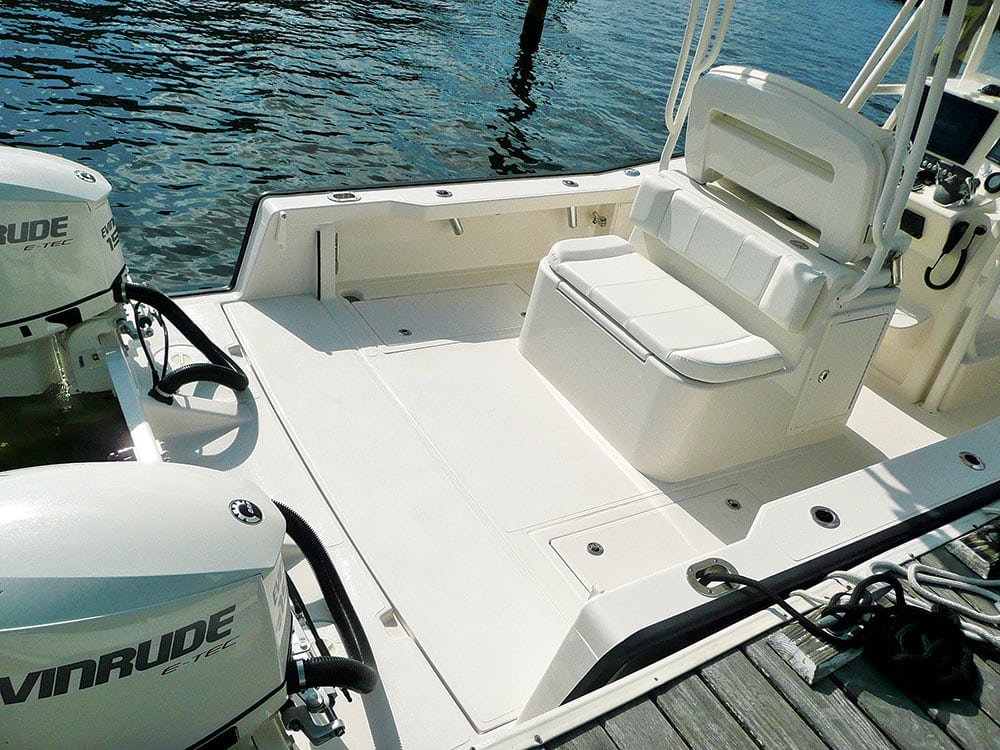
The design caught on with anglers, scuba divers and marine scientists. Occasionally, when people question the safety of a boat without a transom, Ellis tells them that the U.S. Coast Guard inspected the vessel and told him it’s the only recreational boat that would pass the agency standards for an offshore commercial boat.
“One-and-a-half-inch scuppers are not big enough to drain the volume of water that could fill a boat,” he says. “If we were ever in such a position, we could drop the door and have the world’s largest scupper.”
Calcutta 263 Specifications:
LOA: 26 ft. 3 in.
Beam: 8 ft. 6 in.
Transom Deadrise: N/A (catamaran)
Draft: 1 ft. 1 in.
Dry Weight: 3,200 lb. (w/o engines)
Max Power: 300 hp
MSRP: $121,900 (w/ twin 150 hp OBs)
Sea Born LX22
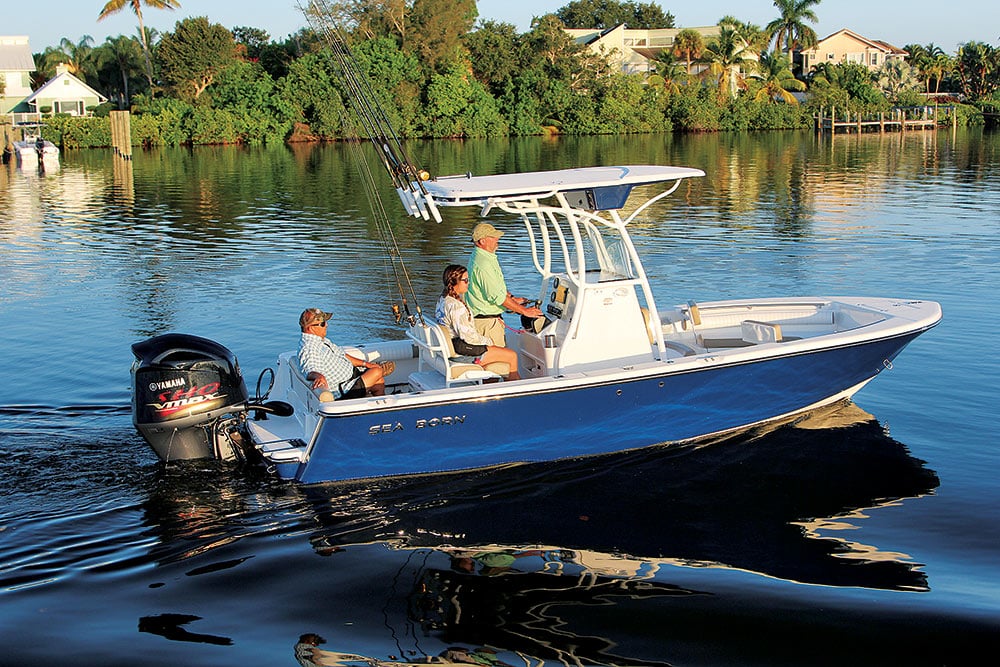
As of the 2017 model year, Sea Born says all of its boats feature a “modern” transom similar to the one at the aft end of the Sea Born LX22. “The old-school Euro transom gave up far too much of the boat for engine mounting and splashwells,”
says Sean McCoy, Sea Born marketing director. “On a 22-footer, we estimated 10 percent of the boat was lost, which is excessive and inefficient.”
The center console LX22 features a reverse tumblehome, integrated swim platform and an 8-inch setback bracket for the outboard. Sea Born took the extra space and created a 60/40 aft bench seat nestled beside a livewell to port and featuring a transom door as part of the starboard backrest.
The cushioned seat bottoms lift up to expose a bilge hatch and insulated drink box. Opt for the tournament package, and the bench’s backrest becomes removable.
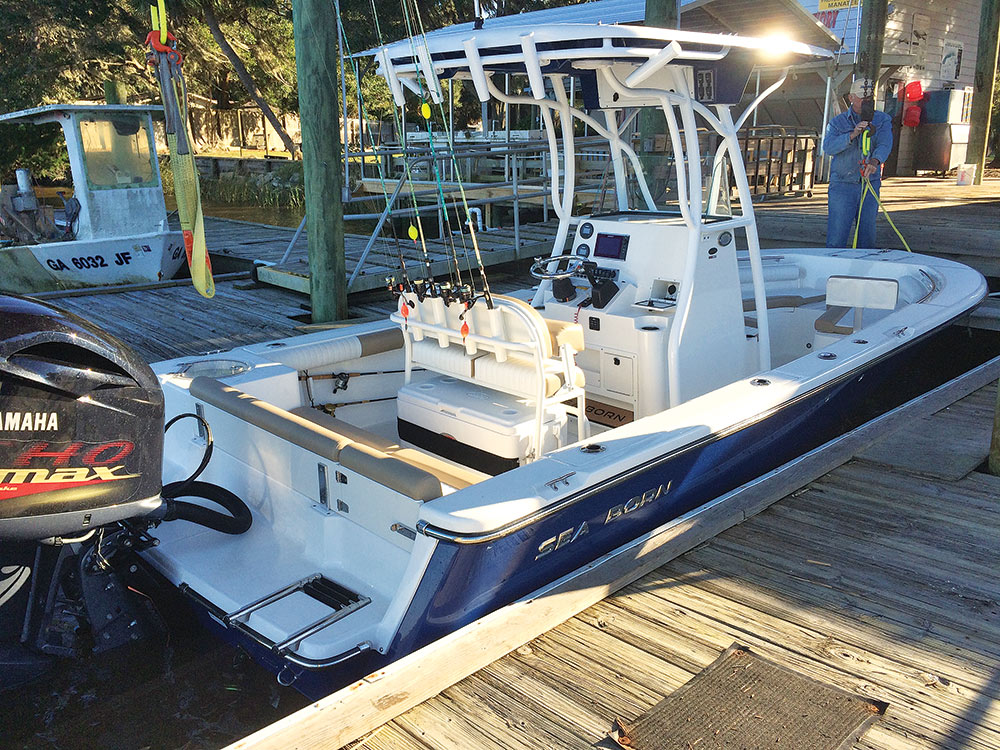
“A few other benefits of moving the engine back are cleaner water and flat swim platforms without tripping hazards via the splashwell; it also puts the angler closer to the stern,” McCoy says.
The new transom style has gained a quick following, he says, “which is why most of our center consoles, bay and offshore boats utilize modern-style transoms with stepped hulls. On our flats boats, we use similar logic, installing jack plates and a model-specific molded bracket on the FX25.”
Sea Born LX22 Specifications
LOA: 22 ft. 5 in.
Beam: 8 ft. 6 in.
Transom Deadrise: 18 deg.
Draft: 1 ft. 1 in.
Dry Weight: 2,300 lb. (w/o engine)
Max Power: 250 hp
MSRP: $58,788 (w/ Yamaha F250)
World Cat 230CC
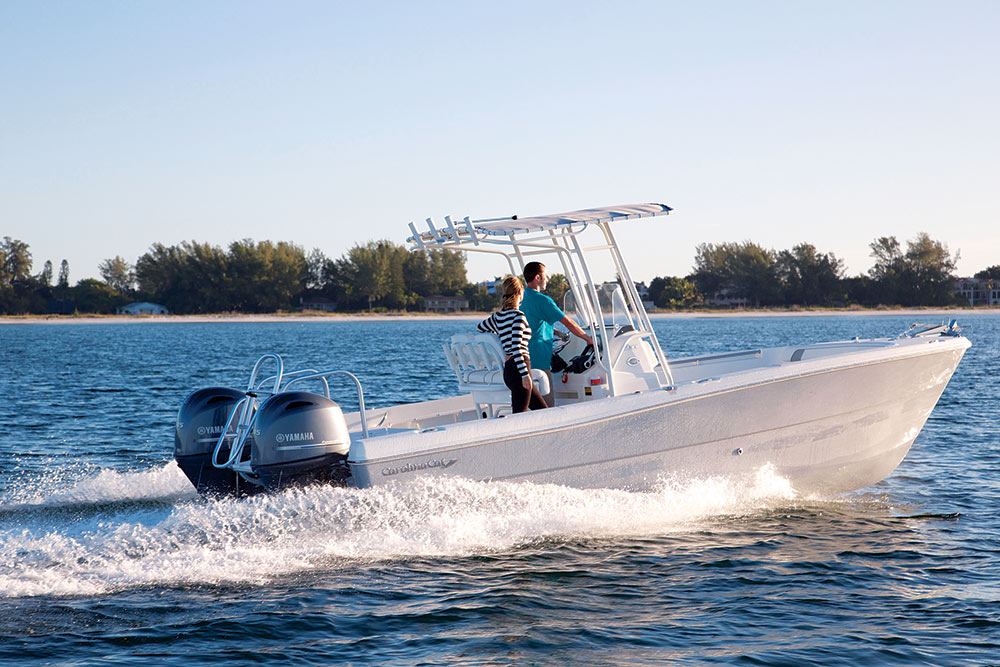
Unlike all other World Cat models, the 230CC and its sister hulls, the 230DC and 230SD, do not come with a transom door that opens onto a bracket and swim platform. Rather, they offer an elevated aft deck that integrates two fold-down jump seats, a livewell and a nonskid platform extending aft between the engines.
The twin outboards bolt to the transom on either side of the platform; they’re centered above each of the catamaran’s sponsons. Each engine has its own splashwell.
As an option, World Cat can add an extension to the nonskid platform, and then top the whole thing with a railing and dive ladder. “This unique design extends the fishing platform aft,” says Dave Tuchler, vice president of marketing. “World Cats already enjoy the advantage of a broad bow area; with cushions removed, that makes for a significant fishing area.”
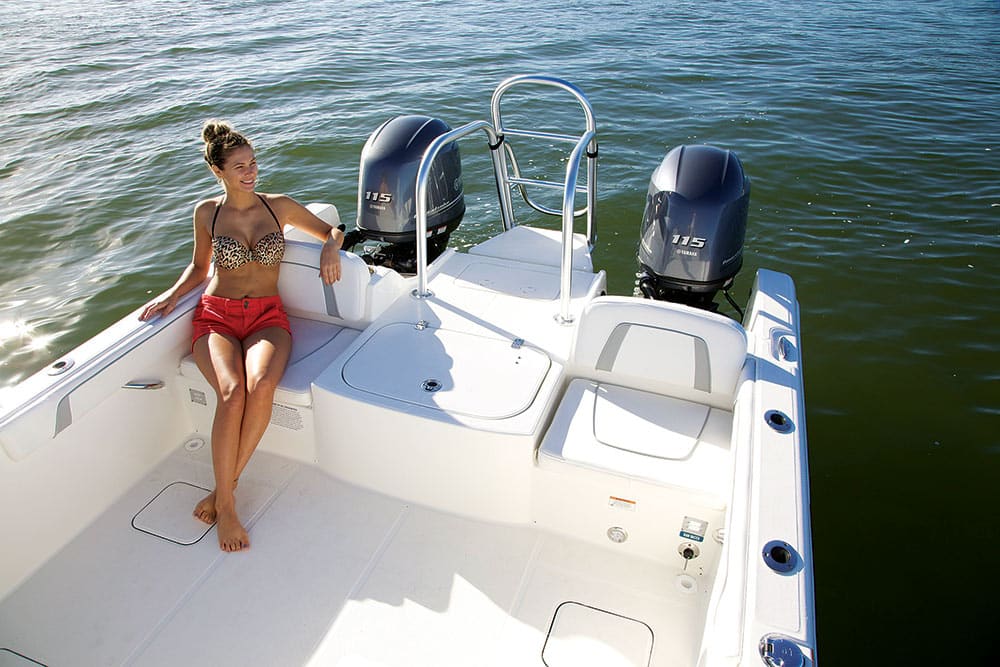
While the 230CC was built to fish offshore, Tuchler says it also draws a scant 9 inches due to the displacement of the sponsons along the waterline. The unique transom/platform design allows anglers to spread out for unencumbered casting toward shorelines and channels.
The 230 also features an ample 30-gallon livewell and 89 gallons of fuel capacity. Typical wide-open throttle speed is 42 mph, according to World Cat performance specifications. At a cruising speed of 22 mph, it achieves 3.3 mpg.
World Cat 230CC Specifications
LOA: 22 ft. 7 in.
Beam: 8 ft. 6 in.
Transom Deadrise: N/A (catamaran)
Draft: 9 in.
Dry Weight: 4,000 lb. (w/ engines)
Max Power: 230 hp
MSRP: $81,292 (w/ twin Yamaha F115s)
Mag Bay 33
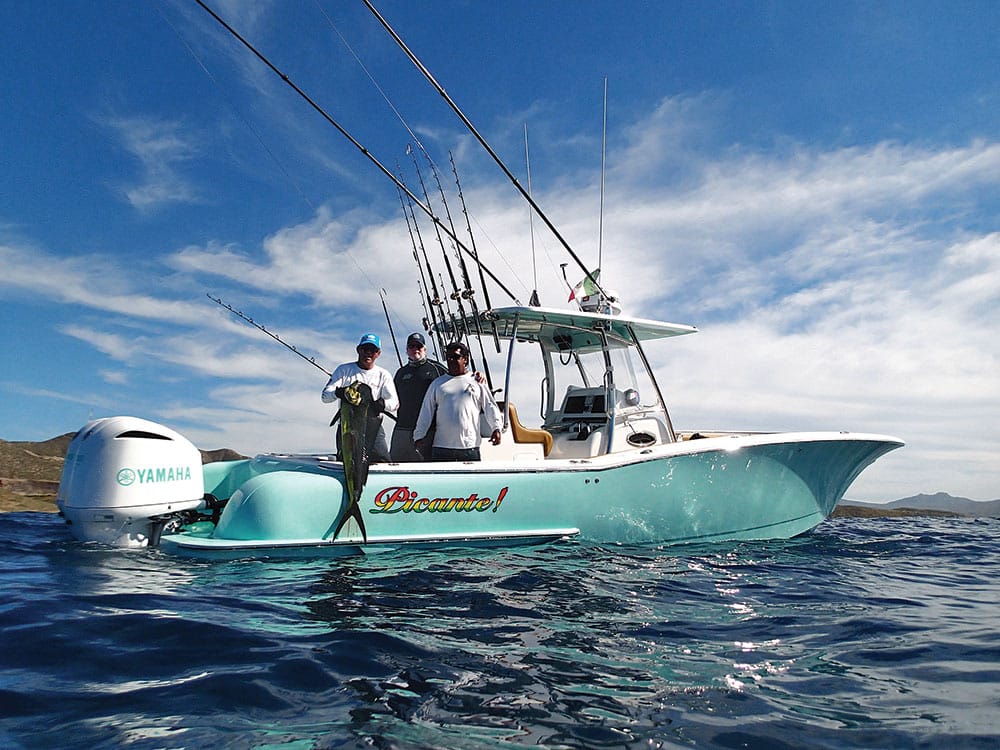
The way Mag Bay’s Phil Bourque describes the 33 perfectly matches the vessel’s classic looks. It’s as if he couldn’t explain it any other way: “The sheer line on the Mag Bay 33 blends into the tumblehome, which extends into the transom, featuring curves that straddle the splashwell,” says Bourque, vice president of sales and marketing. “This design did require some extensive tooling (three-piece hull mold plus deck), but it was well worth it.”
He continues: “The deck is actually bonded and faired in at the round portion of our transom, so — in theory — there is no hull-to-deck joint aft, and the boat is stronger in this area. As such, one could argue our transom construction integrity is superior to the traditional approach of a sandwich and fastened hull joint.”
Mag Bay’s co-founder Mike Howarth was an original partner in Cabo Yachts. Howarth’s son and Mag Bay’s other co-founder — Barrett — helped build Cabo boats from an early age. Bourque says the team’s quality approach comes from these roots.
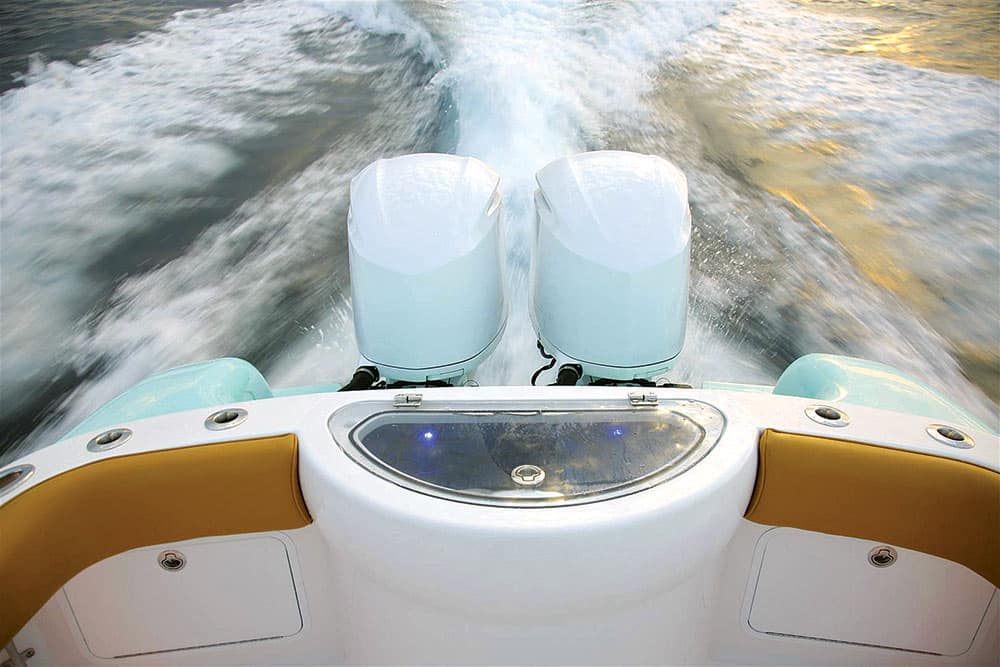
“With our execution of quality and the unique design, we feel Mag Bay is positioned to bridge the gap between the upper end of the volume-production boats and the custom guys,” he says.
The transom design speaks volumes to many potential customers, Bourque reports. He expects it to be featured in the team’s next build. “Additionally, the aft tumblehome extension makes for great storage that runs deep into the transom. It’s great for fenders and lines so those items don’t crowd valuable fish box or other storage.”
Mag Bay 33 Specifications
LOA: 33 ft. 6 in.
Beam: 10 ft.
Transom Deadrise: 22 deg.
Draft: 2 ft.
Dry Weight: 10,200 lb. (w/ engines)
Max Power: 700 hp
MSRP: $294,000 (w/ twin Yamaha F300s)
Regulator 31
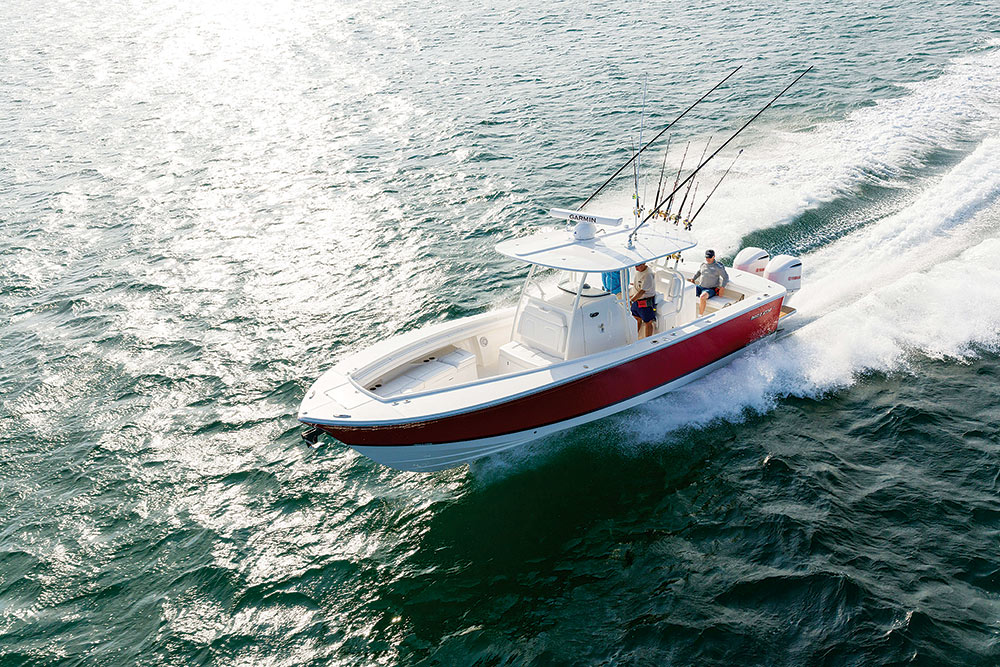
All seven of Regulator’s models feature a full transom and an Armstrong bracket. “Customers love it. This was the hallmark of our original 26 design, and part of the reason for its popularity over the past 30 years,” says Regulator president Joan Maxwell. “With a full transom and bracket, you’re maximizing running surface and deck space, giving you the ride you’ve come to expect from a Regulator, and the comfort to roam as you fish and enjoy the boat with family and friends.”
Regulator lists many of the reasons for this design:
It protects those on the boat, making it easy to stay dry and comfortable.
Coaming pads line the entire boat, including the transom.
The full transom also acts as a sound barrier, making the ride quieter.
The design provides plenty of space at the proper height for compartments such as fish boxes, livewells, ice chests and storage.
The full transom/bracket plays a crucial role in the boat’s balance. With the weight farther back, the console can be farther aft as well, creating more overall deck space.
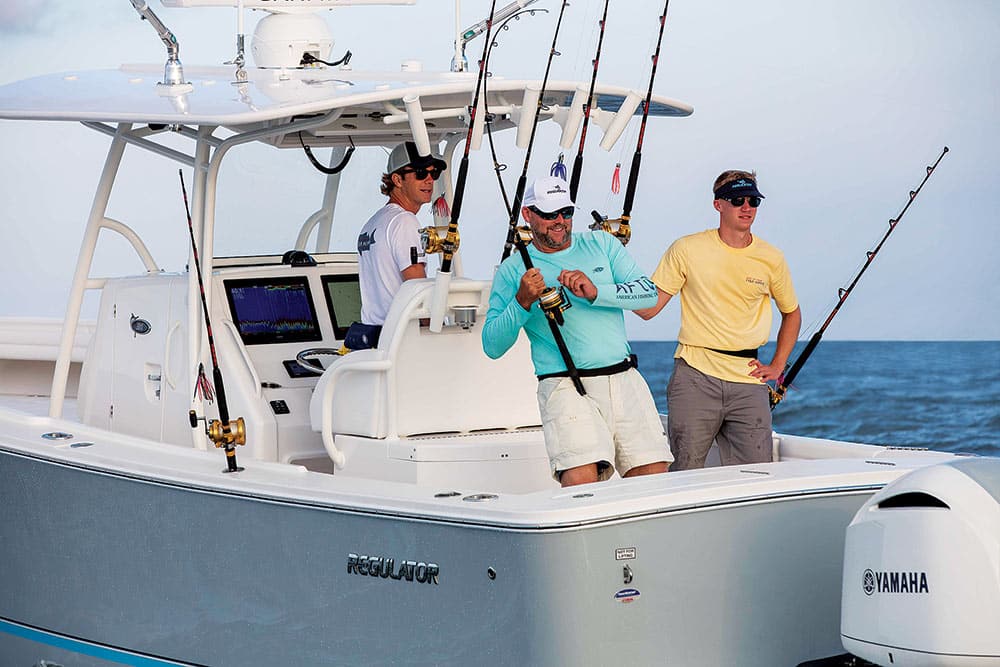
“The bracket acts as a lever for the boat, giving superior performance by distancing the prop from the center of gravity,” says Regulator manufacturing engineer Don Seal. “The bracket also provides flotation, keeping the center of gravity the same in static and dynamic situations.”
The Regulator 31‘s LOA, which includes the bracket and outboards, is 36 feet 5 inches long, which creates a longer running surface, contributing to a better ride.
The bracket allows the engines to tilt forward completely, keeping the props out of the water when needed and allowing for easy maintenance.
Regulator 31 Specifications
LOA: 36 ft. 5 in.
Beam: 10 ft. 4 in.
Transom Deadrise: 24 deg.
Draft: 2 ft. 1 in.
Dry Weight: 10,500 lb. (w/ engines)
Max Power: 600 hp
MSRP: $242,995 (w/ twin Yamaha F300s)
Barker Calibogue Bay
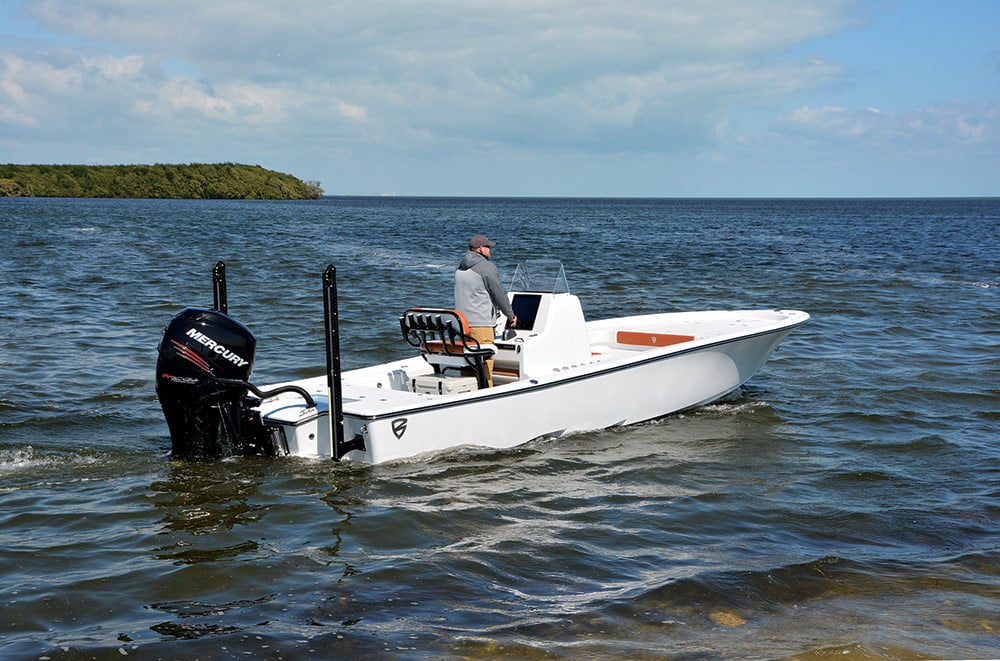
Anglers may have noticed that many bay-boat and small-offshore-boat builders today have eliminated the splashwell from their transom designs and added a jack plate to assist with engine clearance. On bay boats in particular, that alteration extends the aft deck, providing more casting space.
Kevin Barker, who makes both a bay-boat design and a 26-foot hybrid vessel at Barker Boatworks, explains it this way: “All outboard-powered boats that have the motors mounted traditionally on the transom require a splashwell to allow the steering and rigging hardware to clear the deck when the motor is tilted. Over time, as the transom flexes with use, it can develop gelcoat cracks in the corners of the well.
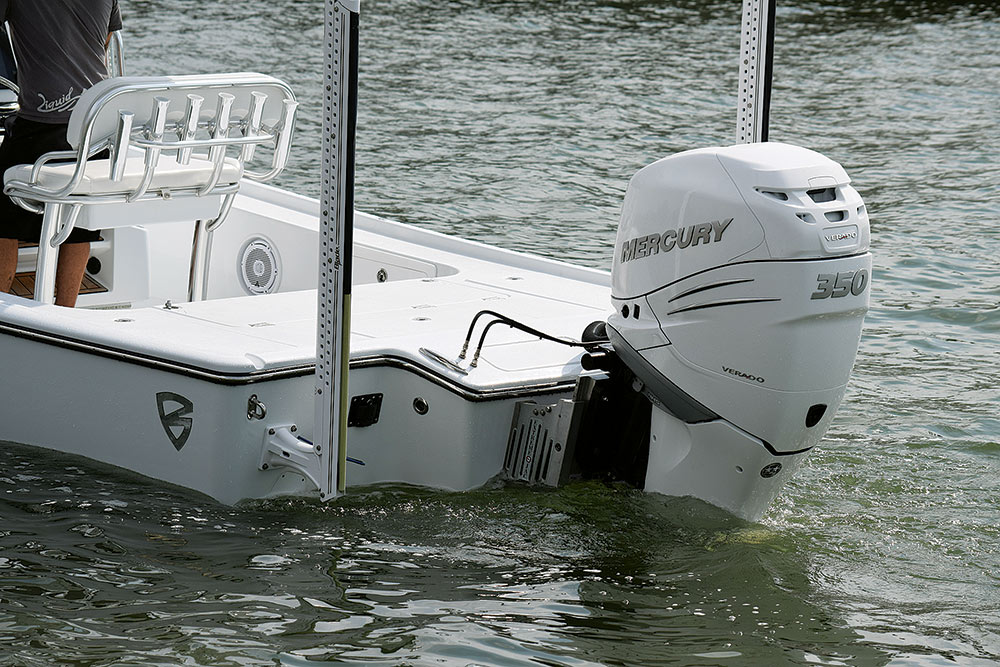
“Although this is not necessarily a structural problem, it is a cosmetic one. Our boats come standard with a jack plate so there are no issues with the hardware hitting the deck. This allowed us to remove the splashwell from the transom design, giving the boat a much cleaner look.”
Customers say they appreciate the broader, flatter deck and compliment the styling of the setback, Barker says. “We don’t plan on making any changes to our design.”
Barker Calibogue Bay Specifications
LOA: 25 ft. 6 in.
Beam: 9 ft. 3 in.
Transom Deadrise: 18 deg.
Draft: 1 ft. 4 in.
Dry Weight: 4,250 lb. (w/ engine)
Max Power: 627 hp
MSRP: $130,000 w/ Mercury 300 Verado Pro and Amera Trail trailer

